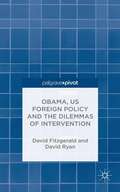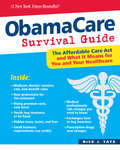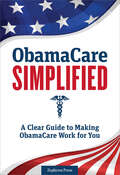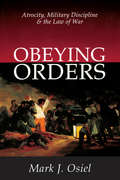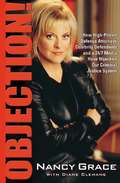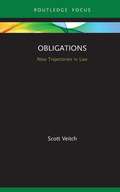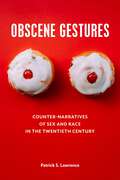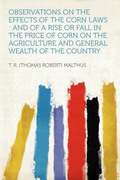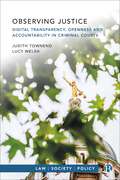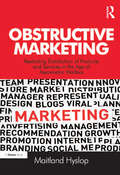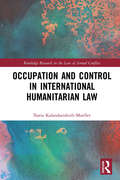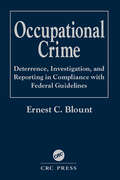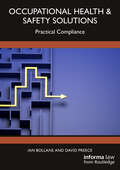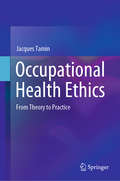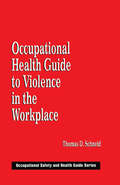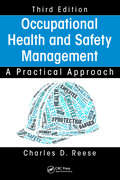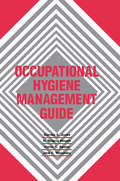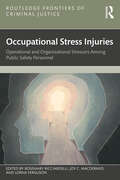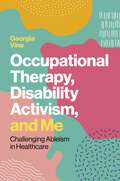- Table View
- List View
Obama, US Foreign Policy and the Dilemmas of Intervention
by David Fitzgerald David RyanThis timely study analyses the ways in which competing ideologies and cultural narratives have influenced the Obama administration's decision-making on Iraq, Afghanistan, Libya and Syria, situating these decisions within the broader history of American foreign policy.
ObamaCare Survival Guide
by Nick J. TateWhen President Barack Obama signed the Patient Protection and Affordable Care Act, he handed Americans one of the most sweeping pieces of social legislation in U.S. history. Now that the Supreme Court has upheld ObamaCare, it is imperative that the American people understand the overwhelming impact it will have on their lives. The Affordable Care Act totals more than 2,700 pages and comprises nearly 500 provisions. For the first time, Humanix Books provides an easy-to-read guide to the law and its implications for every American. The ObamaCare Survival Guide: The Affordable Care Act and What It Means for You and Your Healthcare is the first guide book to help Americans understand the intricacies of ObamaCare. It serves as a valuable resource for those currently insured, those who are not, and the tens of millions of seniors, youth, business people and others who will be affected by the new law. About the Author: Nicholas J. Tate is an award-winning journalist and editor who has written extensively about health and consumer affairs issues. After a fellowship at the Harvard School of Public Health, he authored â œThe Sick Building Syndrome.â His work has also appeared in the Miami Herald, Sun Sentinel, Atlanta Journal-Constitution, Boston Herald, Newsmax and other publications.
Obamacare Simplified: A Clear Guide to Making Obamacare Work for You
by Zephyros PressObamaCare is a complex law that will affect every single American. Everyone has an opinion about ObamaCare, but few people actually understand how the Affordable Care Act works. ObamaCare Simplified navigates you through the intricacies of the health care law and explains what it means for you. Whether you are satisfied with your present insurance or seeking to get insured, ObamaCare Simplified informs you of your rights, presents the facts, and will help you make well-informed decisions when it comes to your health care plan. ObamaCare Simplified provides an easy-to-follow guide to the Affordable Care Act and what you need to know, offering: An overview of the goals and structure of ObamaCare, and how it changes the current health care system A "how it works" section that explains the individual mandate, insurance exchanges, and ObamaCare funding An ObamaCare timeline that provides a year-by-year breakdown of the law's implementation and what you need to know Spotlights on "what ObamaCare means for you," which explore the different impact of the law on various groups, including: senior citizens, immigrants, small-business employers, employees, uninsured individuals, and more Information on how ObamaCare affects individuals, depending on age, income, and employment status Taking care of your health should be your most vital priority. ObamaCare Simplified is your complete guide to understanding how ObamaCare works and what it means for your health care.
Obeying Orders: Atrocity, Military Discipline and the Law of War
by Mark J. OsielA soldier obeys illegal orders, thinking them lawful. When should we excuse his misconduct as based in reasonable error? How can courts convincingly convict the soldier's superior officer when, after Nuremberg, criminal orders are expressed through winks and nods, hints and insinuations? Can our notions of the soldier's "due obedience," designed for the Roman legionnaire, be brought into closer harmony with current understandings of military conflict in the contemporary world? Mark J. Osiel answers these questions in light of new learning about atrocity and combat cohesion, as well as changes in warfare and the nature of military conflict. Sources of atrocity are far more varied than current law assumes, and such variations display consistent patterns. The law now generally requires that soldiers resolve all doubts about the legality of a superior's order in favor of obedience. It excuses compliance with an illegal order unless the illegality - as with flagrant atrocities - would be immediately obvious to anyone. But these criteria are often in conflict and at odds with the law's underlying principles and policies. Combat and peace operations now depend more on tactical imagination, self-discipline, and loyalty to immediate comrades than on immediate, unreflective adherence to the letter of superiors' orders, backed by threat of formal punishment. The objective of military law is to encourage deliberative judgment. This can be done, Osiel suggests, in ways that enhance the accountability of our military forces, in both peace operations and more traditional conflicts, while maintaining their effectiveness. Osiel seeks to "civilianize" military law while building on soldiers' own internal ideals of professional virtuousness. He returns to the ancient ideal of martial honor, reinterpreting it in light of new conditions, arguing that it should be implemented through realistic training in which legal counsel plays an enlarged role rather than by threat of legal prosecution. Obeying Orders thus offers a compelling answer to the question that has most haunted the moral imagination of the late twentieth century: the roots - and restraint - of mass atrocity in war.
Objection!: How High-Priced Defense Attorneys, Celebrity Defendants, and a 24/7 Media Have Hijacked Our Criminal Justice System
by Nancy Grace Diane ClehaneCourt TV host Nancy Grace presents her case in this behind-the-scenes look at the high-profile cases everyone is talking about ancy Grace is a name millions of Americans recognize from her regular appearances on Court TV and Larry King Live. Legions of loyal fans tune in for her opinions on today's high-profile cases and her expert commentary on the challenges facing the American judicial system. Now, in Objection!, she makes her case for what's wrong with the legal system and what can be done about it.
Obligations
by Martin HoggObligations: Law and Language is the first work of its kind to examine in depth the fundamental language used by courts, legislators, and academic commentators when describing the nature of obligations law. A comparative perspective is taken, examining the law of England, Scotland, the United States, Canada, and Australia, and an in-depth analysis is provided of the major legal commentaries, statutes, and case law from each jurisdiction. In exploring such fundamental words as obligation, liability, debt, conditional, unilateral, mutual, and gratuitous, the author examines the often confusing and contradictory ways in which basic structural language has been used, and brings clarity to a core area of legal theory and practice.
Obligations: New Trajectories in Law (New Trajectories in Law)
by Scott VeitchObligations: New Trajectories in Law provides a critical analysis of the role of obligations in contemporary legal and social practices. As rights have become the preeminent feature of modern political and legal discourse, the work of obligations has been overshadowed. Questioning and correcting this dominant image of our time, this book brings obligations back into view in a way that fits better with the realities of contemporary social life. Following a historical account of the changing place and priorities of obligations in modernity, the book analyses how obligations and practices of obedience are core to understanding how law sustains conditions of inequality. But it also explores the enduring role obligations play in furthering individual and collective well-being, highlighting their significance in practices that prioritize human and environmental needs, common goods, and solidarity. In doing so, it also offers an alternative and cogent assessment of the force, and the potential, of obligations in contemporary societies. This original jurisprudential contribution will appeal to an academic and student readership in law, politics, and the social sciences.
Obscene Gestures: Counter-Narratives of Sex and Race in the Twentieth Century
by Patrick S. LawrenceDrawing on sources as diverse as Supreme Court decisions, nightclub comedy, congressional records, and cultural theory, Obscene Gestures explores the many contradictory vectors of twentieth-century moralist controversies surrounding literary and artistic works from Henry Miller’s Tropic of Cancer to those of Toni Morrison, Alice Walker, Kathy Acker, Robert Mapplethorpe, 2 Live Crew, Tony Kushner, and others. Patrick S. Lawrence dives into notorious obscenity debates to reconsider the divergent afterlives of artworks that were challenged or banned over their taboo sexual content to reveal how these controversies affected their critical reception and commercial success in ways that were often determined at least in part by racial, gender, or sexual stereotypes and pernicious ethnographic reading practices.Starting with early postwar touchstone cases and continuing through the civil rights, feminist, and LGBTQ+ movements, Lawrence demonstrates on one level that breaking sexual taboos in literary and cultural works often comes with cultural cachet and increased sales. At the same time, these benefits are distributed unequally, leading to the persistence of exclusive hierarchies and inequalities.Obscene Gestures takes its bearings from recent studies of the role of obscenity in literary history and canon formation during the late nineteenth and early twentieth centuries, extending their insights into the postwar period when broad legal latitude for obscenity was established but when charges of obscenity still carried immense symbolic and political weight. Moreover, the rise of social justice movements around this time provides necessary context for understanding the application of legal precedents, changes in the publishing industry, and the diversification of the canon of American letters. Obscene Gestures, therefore, advances the study of obscenity to include recent developments in the understanding of race, gender, and sexuality while refining our understanding of late-twentieth-century American literature and political culture.
Obscenity and Film Censorship
by Bernard WilliamsWhen it first appeared in 1979, the Williams Report on Obscenity and Film Censorship provoked strong reactions. The practical issues and political principles examined are of continuing interest and remain a crucial point of reference for discussions on obscenity and censorship. Presented in a fresh series livery for the twenty-first century, and with a specially commissioned preface written by Onora O'Neill, illuminating its continuing importance and relevance to philosophical enquiry, this abridged edition of Bernard Williams's Report presents all the main findings and arguments of the full report, central to which is the application of Mill's 'harm principle' and the conclusion that restrictions are out of place where no harm can be reasonably thought to be done.
Obscurity and Clarity in the Law: Prospects and Challenges
by Sophie Cacciaguidi-FahyThis book explores the intricate and multi-dimensional conception of clarity and obscurity in the law. It presents and examines the most recent research and theories, giving practical guidance on how to avoid obscurity in legal drafting and its impact on legal interpretation. The book is aimed at a multidisciplinary audience and seeks to promote an interdisciplinary debate on clarity, law and language, calling for the moving of clarity beyond the study of plain language. The aims of the book are thus two fold. The first is to critically reach a nexus between the disciplines of law and language with respect to the debates on clarity in legal discourse. The second is to achieve an international perspective on the issue, drawing from a wide range of legal and political contexts.
Observations on the Effects of the Corn Laws, and of a Rise or Fall in the Price of Corn on the Agriculture and General Wealth of the Country
by T. R. MalthusA revision of the corn laws, it is understood, is immediately to come under the consideration of the legislature. That the decision on such a subject, should be founded on a correct and enlightened view of the whole question, will be allowed to be of the utmost importance, both with regard to the stability of the measures to be adopted, and the effects to be expected from them.
Observing Justice: Digital Transparency, Openness and Accountability in Criminal Courts
by Lucy Welsh Judith TownendThis book examines how major but often under-scrutinised legal, social, and technological developments have affected the transparency and accountability of the criminal justice process. Drawing on empirical and evaluative studies, as well as their own research experiences, the authors explore key legal policy issues such as equality of access, remote and virtual courts, justice system data management, and the roles of public and media observers. Highlighting the implications of recent changes for access to justice, offender rehabilitation, and public access to information, the book proposes a framework for open justice which prioritises public legal education and justice system accountability.
Obstacle Course: The Everyday Struggle to Get an Abortion in America
by Carole Joffe David S. CohenIt seems unthinkable that citizens of one of the most powerful nations in the world must risk their lives and livelihoods in the search for access to necessary health care. And yet it is no surprise that in many places throughout the United States, getting an abortion can be a monumental challenge. Anti-choice politicians and activists have worked tirelessly to impose needless restrictions on this straightforward medical procedure that, at best, delay it and, at worst, create medical risks and deny women their constitutionally protected right to choose. Obstacle Course tells the story of abortion in America, capturing a disturbing reality of insurmountable barriers people face when trying to exercise their legal rights to medical services. Authors David S. Cohen and Carole Joffe lay bare the often arduous and unnecessarily burdensome process of terminating a pregnancy: the sabotaged decision-making, clinics in remote locations, insurance bans, harassing protesters, forced ultrasounds and dishonest medical information, arbitrary waiting periods, and unjustified procedure limitations. Based on patients’ stories as well as interviews with abortion providers and allies from every state in the country, Obstacle Course reveals the unstoppable determination required of women in the pursuit of reproductive autonomy as well as the incredible commitment of abortion providers. Without the efforts of an unheralded army of medical professionals, clinic administrators, counselors, activists, and volunteers, what is a legal right would be meaningless for the almost one million people per year who get abortions. There is a better way—treating abortion like any other form of health care—but the United States is a long way from that ideal.
Obstacles to Ethical Decision-Making
by Patricia H. Werhane Michael S. Pritchard Laura Pincus Hartman Crina Archer Elaine E. EnglehardtIn commerce, many moral failures are due to narrow mindsets that preclude taking into account the moral dimensions of a decision or action. In turn, sometimes these mindsets are caused by failing to question managerial decisions from a moral point of view, because of a perceived authority of management. In the 1960s, Stanley Milgram conducted controversial experiments to investigate just how far obedience to an authority figure could subvert his subjects' moral beliefs. In this thought-provoking work, the authors examine the prevalence of narrow mental models and the phenomenon of obedience to an authority to analyse and understand the challenges which business professionals encounter in making ethical decisions. Obstacles to Ethical Decision-Making proposes processes - including collaborative input and critique - by which individuals may reduce or overcome these challenges. It provides decision-makers at all levels in an organisation with the means to place ethical considerations at the heart of managerial decision-making.
Obstructive Marketing: Restricting Distribution of Products and Services in the Age of Asymmetric Warfare
by Maitland HyslopIn Obstructive Marketing, Maitland Hyslop deals with a very negative kind of activity which embraces activities, legal or otherwise, designed to prevent or restrict the distribution of a product or service, temporarily or permanently, against the wishes of the product manufacturer, service provider or customer. When the author defined this phenomenon as Obstructive Marketing and started to research it more than a decade ago, it was seen as a valid concept that was perhaps ahead of its time. The World has moved on and in the era of globalization a study of this negative aspect of marketing is now required. Obstructive Marketing is now seen as the business equivalent of asymmetric warfare, which is increasingly understood because the rise of the South and East at the expense of the North and West has brought some Obstructive Marketing stratagems into sharp focus. Using the author’s own research, this book explains what Obstructive Marketing is and why it is not called Anti-Marketing. The author explains who practises Obstructive Marketing, where, when and how; and why businesses are particularly vulnerable when entering new markets and engaging in change and innovation. Intriguing concepts such as cultural risk are illuminated along with formal links between Obstructive Marketing, asymmetric warfare and terrorism. This all leads to identification of the need for a strong Government/Business partnership to counter the effects of this darkest kind of marketing.
Occupation and Control in International Humanitarian Law (Routledge Research in the Law of Armed Conflict)
by Natia Kalandarishvili-MuellerThis book presents a systematic analysis of the notion of control in the law of military occupation. The work demonstrates that in present-day occupations, control as such occurs in different forms and variations. The polymorphic features of occupation can be seen in the way states establish control over territory either directly or indirectly, and in the manner in which they retain, relinquish or regain it. The question as to what level and type of control is needed to determine the existence and ending of military occupation is explored in great detail in light of various international humanitarian law instruments. The book provides an anatomy of the required tests of control in determining the existence of military occupation based on the law. It also discusses control in relation to occupation by proxy and when and how the end of control over territory occurs so that military occupation is considered terminated. The study is informed by relevant international jurisprudence. It draws on numerous pertinent case studies from all over the world, various reports by different UN entities and other international organisations, as well as legal doctrine. The book will be a valuable resource for academics, researchers and practitioners working in the fields of international humanitarian law, international public law, and security studies
Occupational Crime: Deterrence, Investigation, and Reporting in Compliance with Federal Guidelines
by Ernest C. BlountDID YOU KNOW? While organizational entities cannot be sent to prison, they can be heavily fined, ordered to make restitution, placed on probation, forced to forfeit property, suffer public and stakeholder recriminations, and can be forced out of business. Avoid these unnecessary repercussions with Occupational Crime: Deterrence, Investigatio
Occupational Health & Safety Solutions: Practical Compliance
by David Preece Ian BollansHealth and safety legislation places significant responsibilities on employers and managers to protect the health and safety of their workers, but the subject area is seen as both complex and technical in nature, often requiring the input of professionals. This book dispels these myths by taking a unique approach, allowing somebody with little or no knowledge of the subject to understand their legal duties and then take a practical step-by-step approach to control workplace risks and prevent accidents.Occupational Health & Safety Solutions: Practical Compliance is a reworking and updating of Jordan Publishing’s Health and Safety Management, published by LexisNexis from 1997 to 2023. The book takes a comprehensive approach by covering the main subject areas of occupational health and safety and is relevant to all types of workplaces. It provides enough background knowledge for the reader to understand what the law requires, and what needs to be done to achieve compliance, with the main emphasis being on practical application. Providing the reader with the ability to manage health and safety through a process of flowcharts, diagrams, and extensive checklists, the book draws on the expertise of the authors and current best practice within industry. Each chapter sets out a clear, practical approach to identifying and managing risks, thereby enabling a robust and successful health and safety management system to be established in any workplace.The book is written for non-safety professionals such as managers and directors who want to discharge and manage their health and safety responsibilities in their workplace without the need to engage a consultant. It will also appeal to the safety professional by providing an authoritative guide to current best practice together with the practicalities of managing health and safety risks.
Occupational Health Ethics: From Theory to Practice
by Jacques TaminThis book provides occupational health (OH) professionals with a theoretical basis for addressing the ethical issues that they confront in their practice. There is often a lack of in-depth moral analysis of the issues that OH practitioners face on a daily basis. The ICOH Code of Ethics sets out the important principles that guide OH practice. This book builds on these core principles, starting from an application of moral theories in the OH context and illustrating how ethical conflicts could be resolved, by carrying out ethical analyses of several case studies. In this way, it aims to link ethical theory to OH practice.
Occupational Health Guide to Violence in the Workplace (Occupational Safety And Health Guide Ser. #2)
by Thomas D. Schneid20 murders every week. 18,000 assaults in the same time. All on the job.Sharp increases in workplace violence continue to take an unfortunate toll on American business-and its employees, families and communities. Preventative measures may be well-intentioned, but pose troubling conflicts in themselves, pitting each employee's privacy vs. overall worker protection.A full-self evaluation of your business and its personnel may be the key to safeguard against workplace violence. Thomas D. Schneid's Occupational Health Guide to Violence in the Workplace provides the important guidelines for that careful, all-encompassing examination.Most books on workplace violence focus on psychological profiles. In a change of pace, Schneid examines the issue from a safety/health professional's viewpoint, taking all angles, legal issues, and potential ramifications into account. Chapters focus on not only in-house efforts to prevent violent incidents, but also government and legal standards directly or indirectly related to worker's rights and corporate liability.Make every effort to prevent workplace violence from hitting home: start with advice from the Occupational Health Guide to Violence in the Workplace
Occupational Health Law
by Diana KlossKloss on 'Occupational Health Law' has become the standard reference work on the subject since it was first published in 1989. Detailed but highly readable, it provides an essential source of information for health professionals working in occupational health and also for human resources staff. In the years since the 4th edition was written there have been many changes in the field of occupational health, which has achieved a higher profile nationally with the publication of Dame Carol Black's review of the health of Britain's working age population in 2008. This edition, which has been fully revised, includes new sections on age discrimination and expert witnesses, and the sections on discrimination, especially disability discrimination, the Working Time Regulations, stress related illness, corporate manslaughter and confidentiality, in particular, have been substantially updated. The established work on the subject Fully revised in line with current legislation and case law Essential reference for occupational health, personnel and health and safety departments 'Essential reading... clear, straight to the point... superb value for money' —Occupational Safety and Health
Occupational Health and Safety Management: A Practical Approach, Third Edition
by Charles D. ReeseReflecting changes in the current health and safety landscape, Occupational Health and Safety Management: A Practical Approach, Third Edition includes examples and tools to facilitate development and implementation of a safety and health management approach. This how-to book is not just an information providing text. It shows you how to write a program and identify hazards as well as involve workers and attain their cooperation. It emphasizes the need for better and more effective communication regarding safety and health.See What’s New in the Third Edition: Chapters on workers’ compensation, terrorism, and Lean safety/sustainability Additional coverage of flammable liquids and ventilation, accident reporting, and accident investigation New compliance requirements as well as expanded accident investigation, environmental, and risk analysis guidelines PowerPoint presentation slides for each chapter A complete and practical guide for the development and management of occupational safety and health programs in any industry setting, the book supplies a management blueprint that can be used for occupational safety and health in any organization, from the smallest to the largest, beginning to develop or wanting to improve its safety and health approach. It includes comprehensive guidelines for development of occupational health and safety programs to a variety of industries and is especially useful for start-up companies.The author takes a total management approach to the development of written programs, the identification of hazards, the mitigation of hazards by the use of common safety and health tools, the development of a safe workforce through communications, motivational techniques, involvement, and training. He addresses the tracking and acceptable risk from both safety and health hazards. He also discusses how to work with and within the OSHA compliance approach as well as how to deal with the OSHA regulations, workers’ compensation, terrorism, and Lean safety. As you understand and apply the guidelines in each chapter, you can put your company on the way toward building a successful and effective safety and health effort for its employers and employees.
Occupational Hygiene Management Guide
by Shirley K. JonesApplicable worldwide, this valuable guide will enable you to develop, implement, and maintain the effective occupational health programs for your company needs. Authored by four experts responsible for environment, health, and safety at different General Electric businesses, it can help you avoid costly business as well as personal liabilities resulting from occupational health problems. This book describes the hazard recognition and control procedures essential to employee preventive health programs. Details the auditing and measurements process, and outlines the procedures necessary to monitor and ensure total effectiveness of your program, both immediate and long-term. A prime feature is the 1989-1990 TLVs (Threshold Limit Values) and BEIs (Biological Exposure Indices) published with permission of the American Conference of Governmental Industrial Hygienists.
Occupational Stress Injuries: Operational and Organizational Stressors Among Public Safety Personnel (Routledge Frontiers of Criminal Justice)
by Rosemary Ricciardelli Lorna Ferguson Joy C. MacDermidThis book explores the stress faced by public safety professionals across an array of occupational fields, such as police, correctional officers, paramedics, and firefighters.Bringing together leading scholars from around the world, it showcases cutting-edge quantitative and qualitative research from across three continents and multiple regions within six countries, introduces key concepts related to occupational and organizational stressors, and provides an overview of the state of current research in key topic areas. Those who have yet to be exposed to the concepts associated with occupational stress injuries, or to the range of theories and methodologies, will be provided with an informative introduction to this topic. It explores the state of current literature on this topic, identifies gaps in our knowledge and approaches to understanding the relationship between occupational stressors and different outcomes, and provides potential responses for reducing or ameliorating occupational stressors experienced by public safety personnel.Aimed at students, academic researchers, public safety practitioners, law enforcement analysts, and public policy-makers, this book will appeal to readers who have some knowledge in this area and are interested in learning more about new and emerging research, as well as those who are well-versed on this topic.
Occupational Therapy, Disability Activism, and Me: Challenging Ableism in Healthcare
by Georgia VineHow can health and social care services better serve people with disabilities? How can we meaningfully challenge ableist practice? What would a truly inclusive system look like?Georgia Vine answers these questions and more as she charts her journey from her experience of children's services to occupational therapist and disability activist. Discussing stigma, independence, and the transition to adulthood, Georgia provides vital insight into the challenges she has faced and the communities she has built along the way.Each chapter includes a reflection log enabling health and social care workers to think critically and practically about what they've learnt and how best to apply it to their role.
